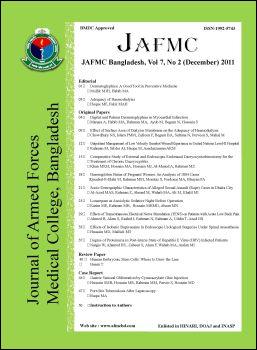Degree Of Proteinuria In Post-Icteric State Of Hepatitis E Virus (Hev) Infected Patients
DOI:
https://doi.org/10.3329/jafmc.v7i2.10395Keywords:
Proteinuria, Hepatitis E virus (HEV), nephropathyAbstract
Introduction: Nephropathies, as one of the multiple extrahepatic features of Hepatitis E virus (HEV) infection, can occur in clinically improved HEV hepatitis patients which in majority of the cases remain clinically silent for a long period. By the time these are reported, patients have already developed renal insufficiency which may even lead to renal replacement therapy. Proteinuria, a simple test in practice, can be a useful tool for early detection of the underlying renal impairment.
Objective: The aim of this study was to detect the presence of proteinuria and to evaluate the degree of proteinuria in HEV- hepatitis patients during post-icteric state.
Materials and Methods: This cross sectional study was conducted on 50 diagnosed patients of clinically improved HEV-hepatitis at the Department of Biochemistry, Bangabandhu Sheikh Mujib Medical University (BSMMU) with active cooperation of the Department of Hepatology, BSMMU, between July 2006 and June 2007. Cases were chosen carefully, to exclude the acute state of illness and the patients of HEV were selected during their third or fourth follow-up, in their post-icteric phase. The study subjects were grouped according to equal age ranges in group-I (18-26 year) and group-II (27-35 year). Depending on the level of spot urinary protein (mg/dl) the subjects were also categorized as having trace, mild and moderate proteinuria.
Results: The mean age of HEV infected subjects was 24.72±2.59 years. The mean spot urinary protein in age group-II patients was raised compared to age group-I and the difference was highly significant (p<0.001). Moreover, there was no significant difference (p>0.05) of spot urinary protein of male and female. Majority of HEV patients (42%) presented with mild proteinuria and mostly (53.3%) was of age group-I.
Conclusion: Spot urinary protein concentration should be checked in every HEV- hepatitis patient to detect the presence and level of proteinuria.
DOI: http://dx.doi.org/10.3329/jafmc.v7i2.10395
JAFMC 2011; 7(2): 37-39
Downloads
183
186

